What humans have done to animals requires an act of cognitive dissonance so great that it pretty much forms a crevasse down the middle of our collective psyche. This chasm is at the centre of Zooveillance, a new exhibition at the New Media Gallery in New Westminster.
The exhibition reminded me of a film called The Ghosts in Our Machine that I programmed for DOXA Documentary Film Festival in 2013. Ghosts depicts the reality of factory farming, fur production, medical experiments and other horrors. The content was startling enough, but what was even more striking was the audiences’ reaction. In a festival that regularly featured just about every atrocity undertaken by humans against other humans, people completely melted down in the face of animals suffering.
I remember being taken aback by this. But as New Media Gallery curator Sarah Joyce points out, “It’s not really about animals. It’s about us.”
She is exactly right.
The twisted path to forging new life
Nothing makes the complexities and agonies of empathy more apparent than Alexandra Daisy Ginsberg’s installation The Substitute.
Hailing from South Africa, Ginsberg had some familiarity with rhinoceroses before beginning work on The Substitute, but the news that the last male northern white rhino (Ceratotherium simum cottoni) in the world had died provoked new urgency. The death of the rhino named Sudan spurred Ginsberg to explore not only her own reaction but also the larger implications of this event.
It was the language around Sudan’s demise that caught Ginsberg’s attention. Scientists talked about harvesting the rhino; this meant removing his reproductive organs with the intent of bringing the species back from extinction.
Sudan was the last remaining male of the subspecies. There were two remaining northern white rhinos, both female, who were past reproductive age. In efforts to continue the species, scientists used Sudan’s sperm and in vitro fertilization to gestate an infant in younger southern white rhinos. But, as with many interventions in the natural world, the process was more complex than anyone had anticipated.
Northern white rhinos, as far as rhinos go, are a very social species. And even if researchers succeeded in successfully creating a baby, there would be no others to teach it the ways of its kind. There are other, even darker aspects of the story. Northern white rhinos were driven to extinction by humans killing them for their horns. Before Sudan died at age 45, he had his horn shaved down and was guarded from poachers around the clock.
The Substitute delves deeply into the ethical issues of using biotechnology to bring a species back from the brink, and the human predilection to treat animals as raw material to work out our greed, desires, insecurities and other, even less wholesome stuff. The work takes on fundamental questions around animal rights, as well as thornier stuff about authenticity. Would this fabled infant rhino be genuine, or something of a Frankenstein creation?
In investigating these questions, Ginsberg used research from Google’s AI lab DeepMind to fashion a semblance of the animal in digital form. In describing this chimera, the language used is “artificial agent.” The intent was to allow this creation to learn from his surroundings, gaining awareness of his captivity as he evolved.
In the exhibition, this translates into a digitally rendered creature that evolves from a confluence of blockish, voxelated building materials (think Minecraft) into a fully animated rendition of a rhino. The life-size projection of Sudan, stuck in the confines of an artificial enclosure, does what a real animal might do. It huffs and puffs, shuffling from one corner of the cage to another.
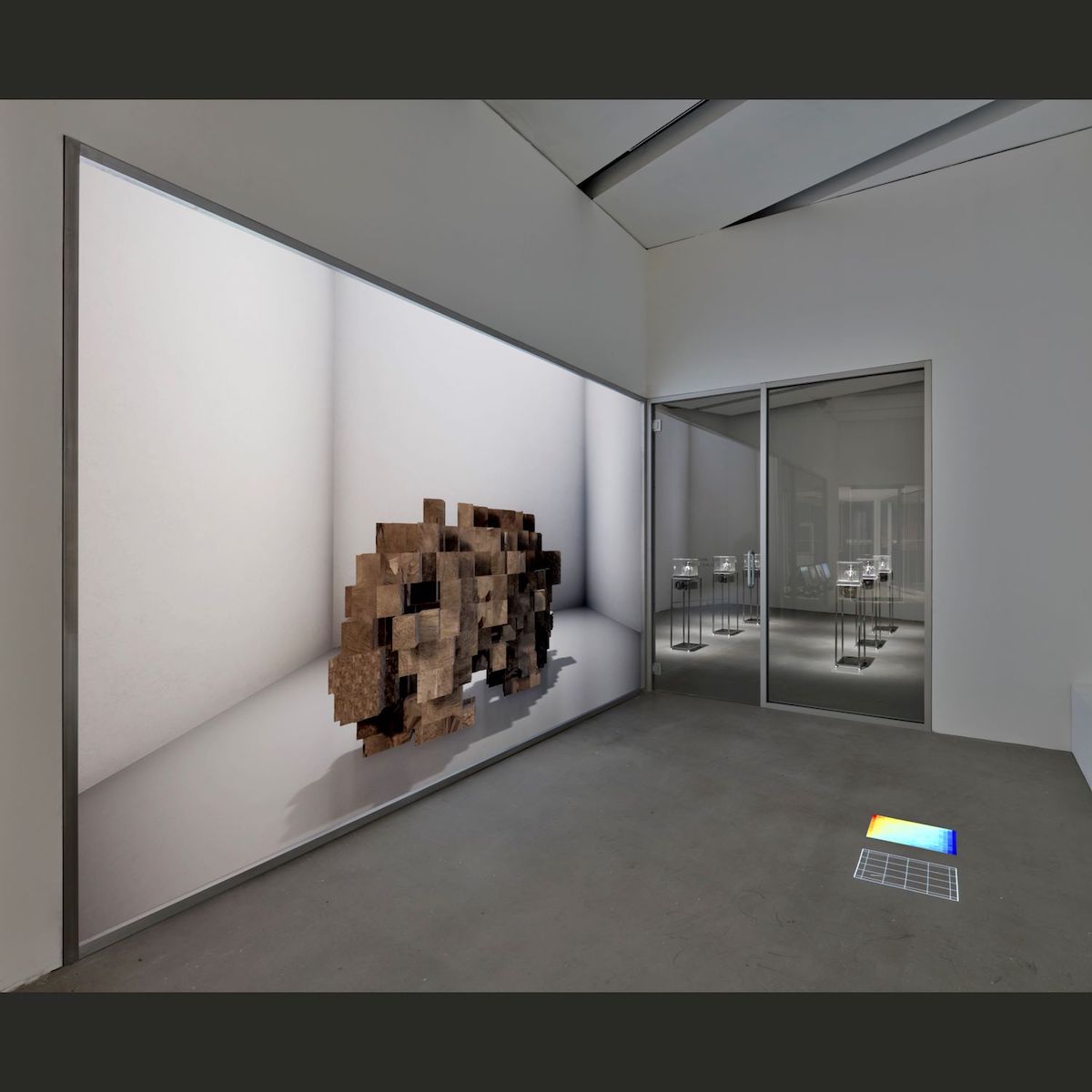
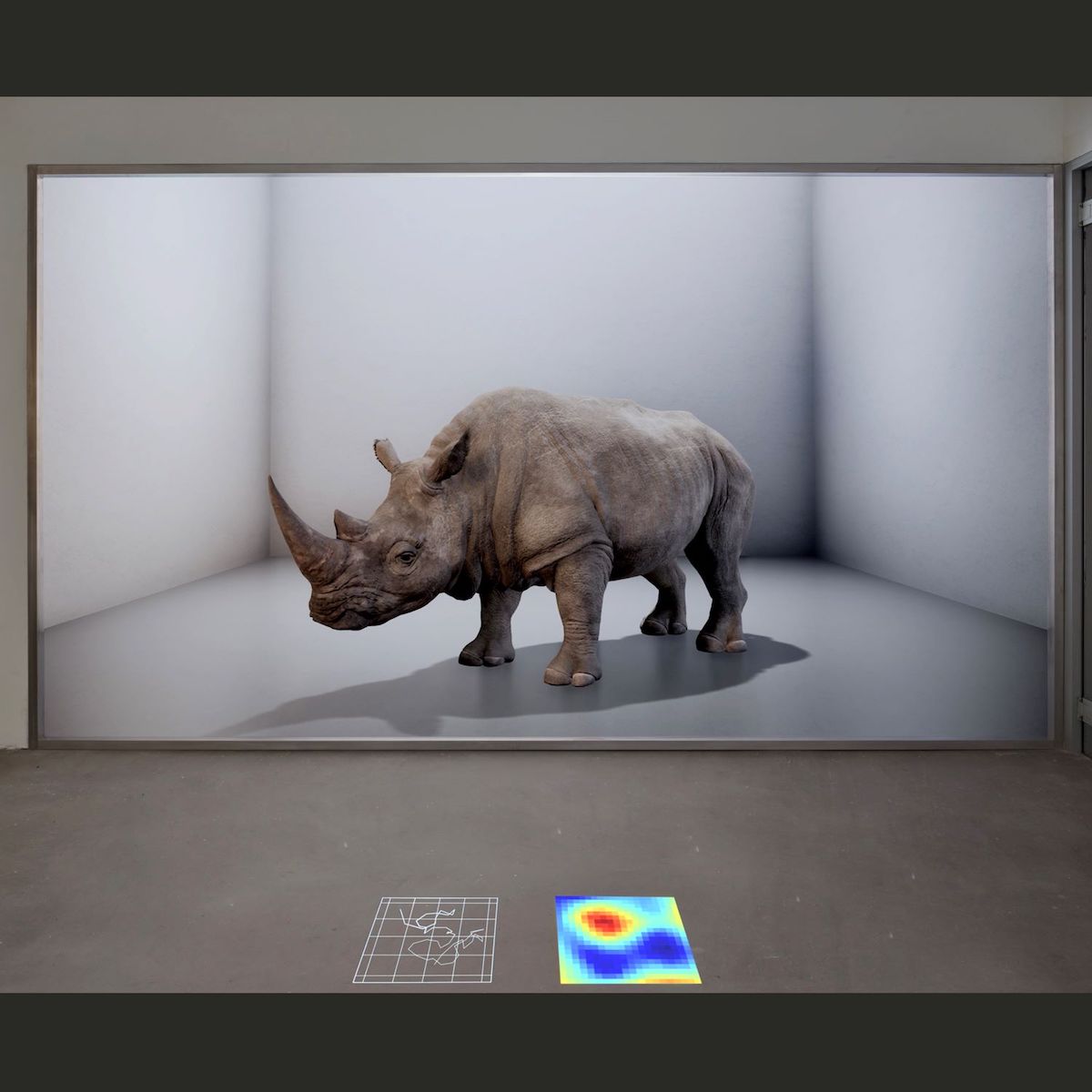
On a secondary screen, the machine logic that governs its movements plays out, anticipating its action. Some of the information about real animals came from a shoebox of material supplied to the artist by Dr. Richard Policht, who documented the behaviours and habits of the last remaining herd of white rhinos.
The levels of technical complexity in the work are legion. But curiously enough, The Substitute hearkens back to a much earlier interpretation of a rhino. Albrecht Dürer’s image of a rhinoceros, created in 1515, was based on a written description and a sketch of an Indian rhinoceros. Despite the fact that the image was wildly inaccurate, it was incredibly popular. Ginsberg’s father had a reproduction of the famous Dürer image hanging on the wall of her childhood home.
In examining the quest to create new forms of life — even while abusing, neglecting and exploiting existing creatures — The Substitute teems with ideas, drawing from technology, personal history, research and art history.
The most singular moment happens at the end of the animated evolution when the faux version of Sudan suddenly fixes onlookers with a profoundly mournful stare as if to say, “What have you done?”
This question hangs in the air, infusing the other works in the show with similarly disquieting demand.
A glitch in the ‘behavioural loop’
Mat Collishaw’s work The Machine Zone engages with some of the same issues as Ginsberg, but in an even more immediate, unsettling fashion.
A member of the visual arts movement called the Young British Artists (a group that includes U.K. wunderkinds Damien Hirst and Tracey Emin), Collishaw is known colloquially as “the clever one.” It’s a well-earned sobriquet. The installation, inspired by the experiments of American psychologist B.F. Skinner, uses some of the same behaviour explored in the animal kingdom to reveal motivation and reward-seeking in the human world.
In a series of transparent vitrines, skeletal birds, exquisitely detailed right down to each cervical vertebra, peck at a food dispensing button, awaiting their reward. It is both creepy and beautiful. This curious mix of attraction and repulsion, augmented by the sound of clicking metal beaks, fills the gallery with a skittering noise that secretes another layer of disquiet.
The critical part of this activity is that there is no reward forthcoming. The birds do not require any nourishment because they are not alive. It’s all an empty exercise in desire, a suitable metaphor for the faux need that drives so much of human behaviour.
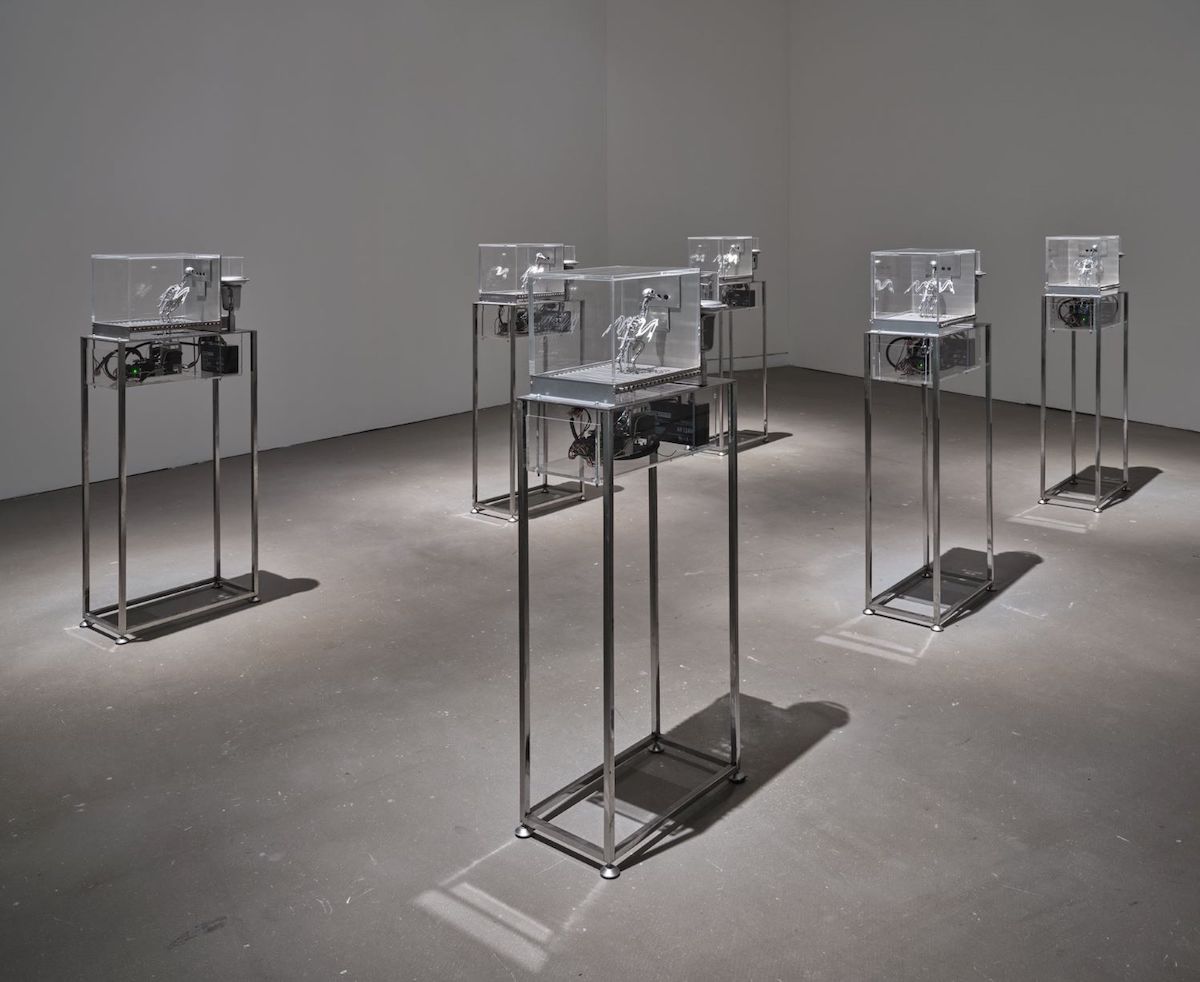
In explaining the piece, Collishaw references the fact that Skinner’s experiments inspired the creation of algorithms in social media. A similar reward system drives humans to keep tapping at our phones or devices for bits of social approbation: likes, shares, comments, etc. This is disturbing enough, but when Skinner’s original animal subjects were moved to a sequence of random rewards, they quickly became addicted to pecking, even though there was no direct correlation between this activity and food.
Here’s where things got even weirder. When the birds made odd little dance moves that resulted in rewards, they then adopted these moves, like so many miniature gamblers blowing on the dice. It was the uncertainty itself that drove this behaviour.
As the piece makes clear, much of Skinner’s work has been used to create similar reactions in humans with regards to social media. What is termed a “behavioural loop” ensued: a glitch in the way that uncertainty and possibility affects us, driving constant iterations of the same impulse.
You can feel it yourself when scrolling through social media, waiting for some dopamine hit to give you a little boost. Almost as soon as it happens, you need another hit. And so it goes.
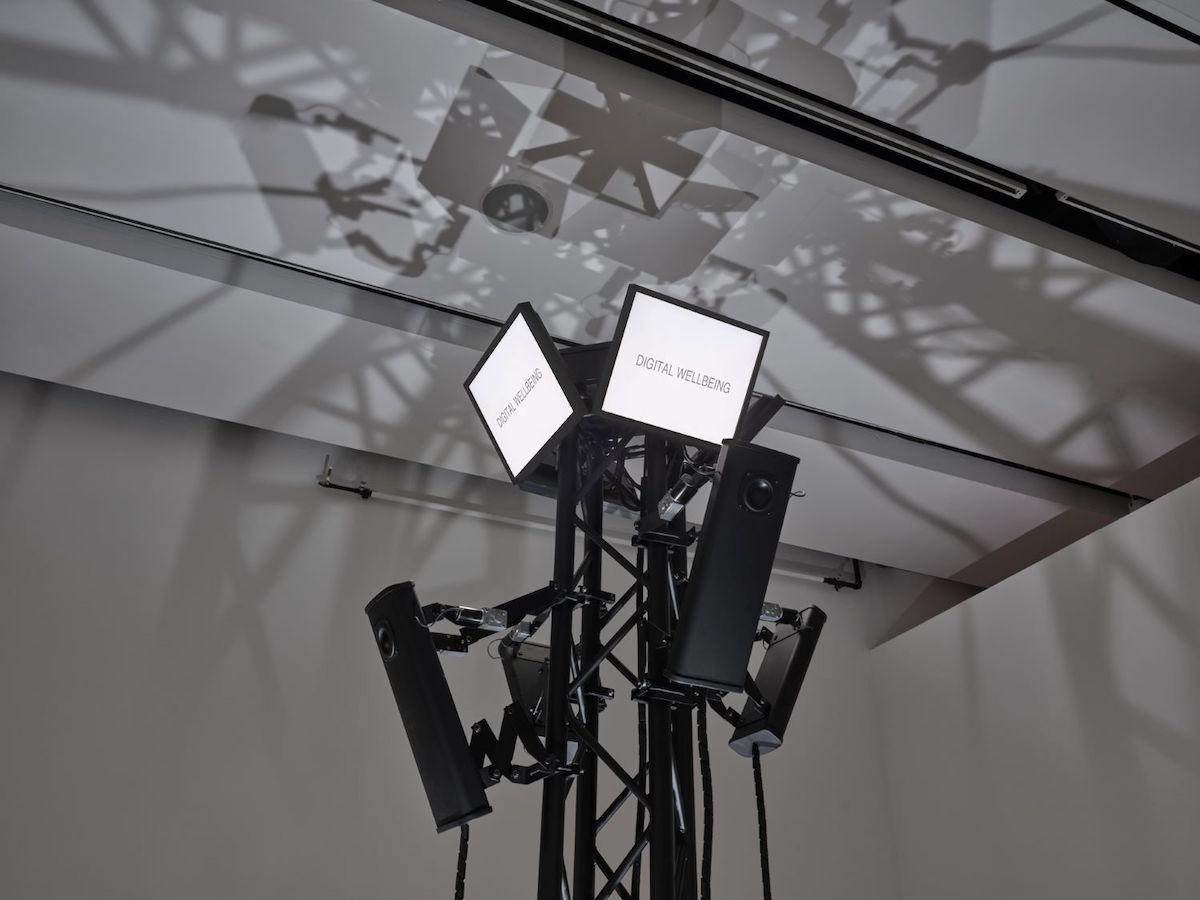
Deep faking the call of apes
In investigating the relationship between humans, the internet and the natural world, Berlin-based media artist Marco Barotti takes these sticky, tricky connections and blows them sky-high in APES.
Barotti’s work frequently involves direct collaboration with researchers and scientists. In APES, filmed interviews with different experts in the field of AI provide clarity and thoughtfulness about the implications of their work. But this relative calm collapses with the main component of the piece.
The so-called APES in the work are kinetic sound sculptures derived from recycled Wi-Fi antennas that cluster on rooftops in urban centres. In Barotti’s installation, they clamber up a central tower like so many miniature King Kongs, shaking the structure with the vehemence and violence of a world gone mad with information. Their activity is driven by screens perched atop the centre spire that reveal the mind-numbing numbers that make up stuff like Google searches, Tinder swipes, Facebook likes, emails, cyberattacks and so forth.
As the numbers ratchet up, the APES get a tad overexcited, screaming and rocking the entire installation. The looming shadows cast by their actions are projected onto the ceiling of the gallery, adding another layer of atavistic unease.
As curator Joyce explains, Barotti was insistent on finding the right placement for the shadow component, meaning for it to function as an embodiment of threat from above.
In addition to the shadows, the sound component adds another harrowing aspect. Barotti explains this connection in his work: “When the counters hit certain key numbers, the sculptures release sonic events composed by an AI trained to deep fake the calls of real apes.”
The screams and cries emanating from the piece at first resemble the cry of a human infant before they slowly evolve into more readily identifiable simian shrieks.
The correlation between our mammalian brains and the beyond-human world that we have fashioned for ourselves, and must now live within, is blunt, brutal and horrifying — but not without a certain dark humour.
It’s tempting to laugh at the crazed apes doing their thing, but the laughter catches in your throat when you realize that you’re also caught up in a world so increasingly beyond our control. Rage against the machine all you like: it doesn’t change much.
Acknowledging our complicity, agency and ongoing acts of suffering that we perpetrate against the rest of the planet’s inhabitants is almost too much to take. But art is one of the few places that provides a space to actively contend with this moral paradox, bridging the cavernous divide between the human and non-human world.
To change anything, you first have to look it in the face. In Zooveillance, the birds, apes and rhinos stare back, waiting for what you’ll do next.
‘Zooveillance’ runs at the New Media Gallery until May 5. ![]()
Read more: Art, Science + Tech, Environment




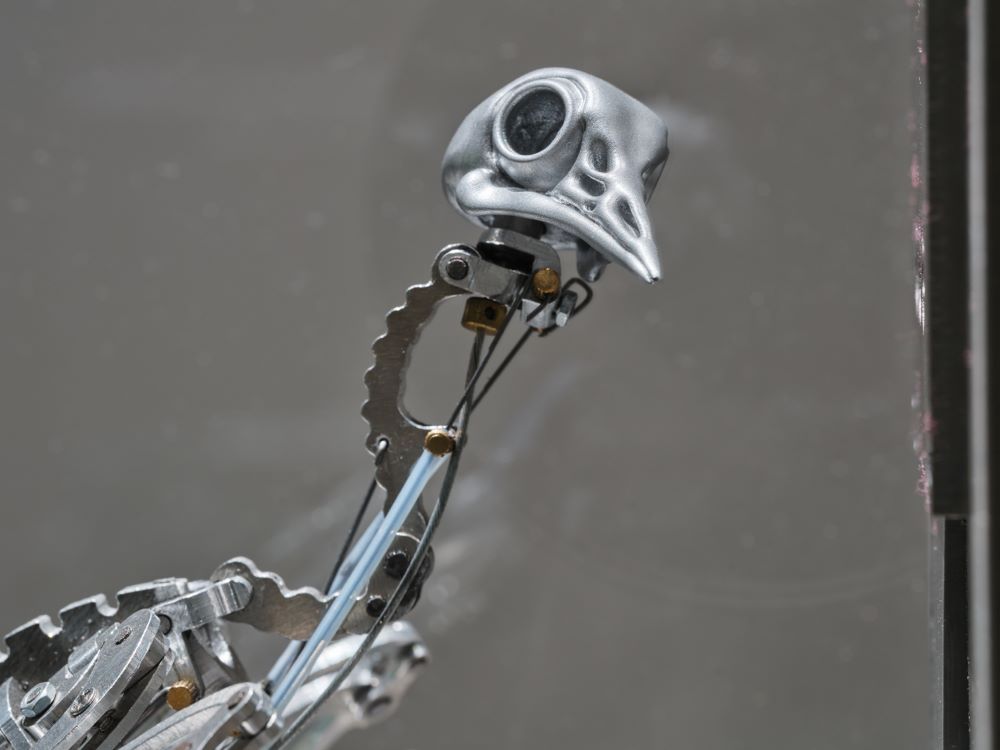












Tyee Commenting Guidelines
Comments that violate guidelines risk being deleted, and violations may result in a temporary or permanent user ban. Maintain the spirit of good conversation to stay in the discussion and be patient with moderators. Comments are reviewed regularly but not in real time.
Do:
Do not: